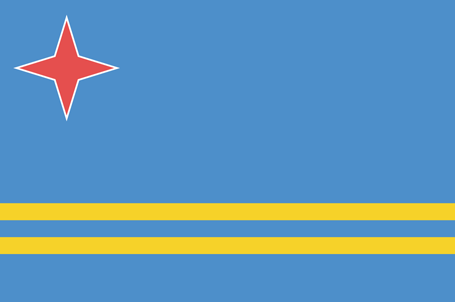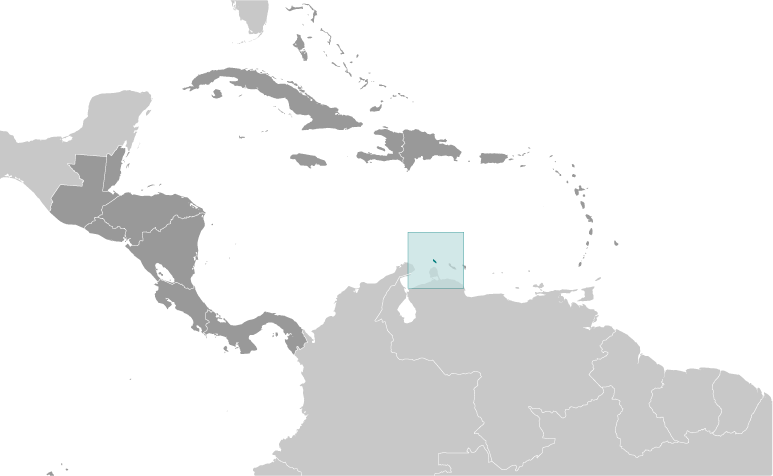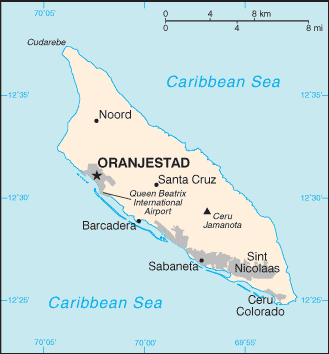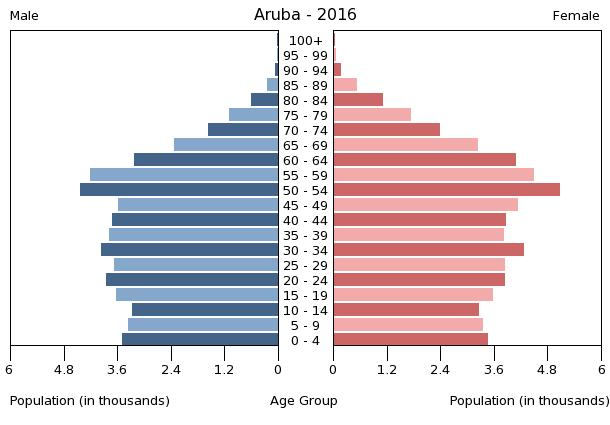Introduction :: ARUBA
-
Discovered and claimed for Spain in 1499, Aruba was acquired by the Dutch in 1636. The island's economy has been dominated by three main industries. A 19th century gold rush was followed by prosperity brought on by the opening in 1924 of an oil refinery. The last decades of the 20th century saw a boom in the tourism industry. Aruba seceded from the Netherlands Antilles in 1986 and became a separate, autonomous member of the Kingdom of the Netherlands. Movement toward full independence was halted at Aruba's request in 1990.
Geography :: ARUBA
-
Caribbean, island in the Caribbean Sea, north of Venezuela
12 30 N, 69 58 W
Central America and the Caribbean
total: 180 sq km
land: 180 sq km
water: 0 sq km
country comparison to the world: 218
slightly larger than Washington, DC
0 km
68.5 km
territorial sea: 12 nm
exclusive economic zone: 200 nm
tropical marine; little seasonal temperature variation
flat with a few hills; scant vegetation
mean elevation: NA
elevation extremes: lowest point: Caribbean Sea 0 m
highest point: Ceru Jamanota 188 m
NEGL; white sandy beaches foster tourism
agricultural land: 11.1%
arable land 11.1%; permanent crops 0%; permanent pasture 0%
forest: 2.3%
other: 86.6% (2011 est.)
NA
most residents live in or around Oranjestad and San Nicolaas; most settlements tend to be located on the less mountainous western side of the island
hurricanes; lies outside the Caribbean hurricane belt and is rarely threatened
difficulty in properly disposing of waste produced by large numbers of tourists
a flat, riverless island renowned for its white sand beaches; its tropical climate is moderated by constant trade winds from the Atlantic Ocean; the temperature is almost constant at about 27 degrees Celsius (81 degrees Fahrenheit)
People and Society :: ARUBA
-
115,120 (July 2017 est.)
country comparison to the world: 189
noun: Aruban(s)
adjective: Aruban; Dutch
Dutch 82.1%, Colombian 6.6%, Venezuelan 2.2%, Dominican 2.2%, Haitian 1.2%, other 5.5%, unspecified 0.1% (2010 est.)
Papiamento (official) (a creole language that is a mixture of Portuguese, Spanish, Dutch, English, and, to a lesser extent, French, as well as elements of African languages and the language of the Arawak) 69.4%, Spanish 13.7%, English (widely spoken) 7.1%, Dutch (official) 6.1%, Chinese 1.5%, other 1.7%, unspecified 0.4% (2010 est.)
Roman Catholic 75.3%, Protestant 4.9% (includes Methodist 0.9%, Adventist 0.9%, Anglican 0.4%, other Protestant 2.7%), Jehovah's Witness 1.7%, other 12%, none 5.5%, unspecified 0.5% (2010 est.)
0-14 years: 17.64% (male 10,189/female 10,115)
15-24 years: 12.78% (male 7,405/female 7,307)
25-54 years: 41.72% (male 23,117/female 24,906)
55-64 years: 14.28% (male 7,664/female 8,773)
65 years and over: 13.59% (male 6,132/female 9,512) (2017 est.)
population pyramid:

Central America and Caribbean
::ARUBA

Population Pyramid
A population pyramid illustrates the age and sex structure of a country's population and may provide insights about political and social stability, as well as economic development. The population is distributed along the horizontal axis, with males shown on the left and females on the right. The male and female populations are broken down into 5-year age groups represented as horizontal bars along the vertical axis, with the youngest age groups at the bottom and the oldest at the top. The shape of the population pyramid gradually evolves over time based on fertility, mortality, and international migration trends.
For additional information, please see the entry for Population pyramid on the Definitions and Notes page under the References tab.
total dependency ratio: 44.6
youth dependency ratio: 27
elderly dependency ratio: 17.5
potential support ratio: 5.7 (2015 est.)
total: 39.3 years
male: 37.5 years
female: 41.1 years (2017 est.)
country comparison to the world: 56
1.27% (2017 est.)
country comparison to the world: 84
12.4 births/1,000 population (2017 est.)
country comparison to the world: 159
8.4 deaths/1,000 population (2017 est.)
country comparison to the world: 82
8.7 migrant(s)/1,000 population (2017 est.)
country comparison to the world: 12
most residents live in or around Oranjestad and San Nicolaas; most settlments tend to be located on the less mountainous western side of the island
urban population: 41.1% of total population (2017)
rate of urbanization: -0.1% annual rate of change (2015-20 est.)
ORANJESTAD (capital) 29,000 (2014)
at birth: 1.02 male(s)/female
0-14 years: 1.01 male(s)/female
15-24 years: 1.01 male(s)/female
25-54 years: 0.93 male(s)/female
55-64 years: 0.87 male(s)/female
65 years and over: 0.64 male(s)/female
total population: 0.9 male(s)/female (2016 est.)
total: 10.7 deaths/1,000 live births
male: 14 deaths/1,000 live births
female: 7.4 deaths/1,000 live births (2017 est.)
country comparison to the world: 131
total population: 76.9 years
male: 73.9 years
female: 80.1 years (2017 est.)
country comparison to the world: 80
1.83 children born/woman (2017 est.)
country comparison to the world: 148
improved:
urban: 98.1% of population
rural: 98.1% of population
total: 98.1% of population
unimproved:
urban: 1.9% of population
rural: 1.9% of population
total: 1.9% of population (2015 est.)
improved:
urban: 97.7% of population
rural: 97.7% of population
total: 97.7% of population
unimproved:
urban: 2.3% of population
rural: 2.3% of population
total: 2.3% of population (2015 est.)
NA
NA
NA
note: active local transmission of Zika virus by Aedes species mosquitoes has been identified in this country (as of August 2016); it poses an important risk (a large number of cases possible) among US citizens if bitten by an infective mosquito; other less common ways to get Zika are through sex, via blood transfusion, or during pregnancy, in which the pregnant woman passes Zika virus to her fetus (2016)
6.1% of GDP (2014)
country comparison to the world: 41
definition: age 15 and over can read and write
total population: 97.5%
male: 97.5%
female: 97.5% (2015 est.)
total: 14 years
male: 13 years
female: 14 years (2012)
total: 28.9%
male: 29.9%
female: 27.5% (2010 est.)
country comparison to the world: 43
Government :: ARUBA
-
conventional long form: none
conventional short form: Aruba
etymology: the origin of the island's name is unclear; according to tradition, the name comes from the Spanish phrase "oro huba" (there was gold), but in fact no gold was ever found on the island; another possibility is the native word "oruba," which means "well-situated"
constituent country of the Kingdom of the Netherlands; full autonomy in internal affairs obtained in 1986 upon separation from the Netherlands Antilles; Dutch Government responsible for defense and foreign affairs
parliamentary democracy (Legislature); part of the Kingdom of the Netherlands
name: Oranjestad
geographic coordinates: 12 31 N, 70 02 W
time difference: UTC-4 (1 hour ahead of Washington, DC, during Standard Time)
none (part of the Kingdom of the Netherlands)
note: Aruba is one of four constituent countries of the Kingdom of the Netherlands; the other three are the Netherlands, Curacao, and Sint Maarten
none (part of the Kingdom of the Netherlands)
National Anthem and Flag Day, 18 March (1976)
previous 1947, 1955; latest drafted and approved August 1985, enacted 1 January 1986 (regulates governance of Aruba but is subordinate to the Charter for the Kingdom of the Netherlands); note - in October 2010, following dissolution of the Netherlands Antilles, Aruba became a constituent country within the Kingdom of the Netherlands (2016)
civil law system based on the Dutch civil code
see the Netherlands
18 years of age; universal
chief of state: King WILLEM-ALEXANDER of the Netherlands (since 30 April 2013); represented by Governor General Alfonso BOEKHOUDT (since 1 January 2017)
head of government: Prime Minister Michiel "Mike" Godfried EMAN (since 30 October 2009)
cabinet: Council of Ministers elected by the Legislature (Staten)
elections/appointments: the monarchy is hereditary; governor general appointed by the monarch for a 6-year term; prime minister and deputy prime minister indirectly elected by the Staten for 4-year term; election last held on 27 September 2013 (next to be held by September 2017)
election results: Michiel "Mike" Godfried EMAN (AVP) elected prime minister; percent of legislative vote - NA
description: unicameral Legislature or Staten (21 seats; members directly elected in a single nationwide constituency by proportional representation vote; members serve 4-year terms)
elections: last held on 22 September 2017 (next to be held in September 2021)
election results: percent of vote by party AVP 39.8%, MEP 37.6%, POR 9.4%, RED 7.1%; seats by party - AVP 9, MEP 9, POR 2, RED 1
highest court(s): Joint Court of Justice of Aruba, Curacao, Sint Maarten, and of Bonaire, Sint Eustatitus and Saba or "Joint Court of Justice" (sits as a 3-judge panel); final appeals heard by the Supreme Court, in The Hague, Netherlands
judge selection and term of office: Joint Court judges appointed by the monarch for life
subordinate courts: Courts in First Instance
Aruban People's Party or AVP [Michiel "Mike" EMAN]
Democratic Electoral Network or RED [L.R. CROES]
People's Electoral Movement Party or MEP [Evelyn WEVER-CROES]
Pueblo Orguyoso y Respeta or POR [O.E. ODUBER];; Real Democracy or PDR [Andin BIKKER]
environmental groups
Caricom (observer), FATF, ILO, IMF, Interpol, IOC, ITUC (NGOs), UNESCO (associate), UNWTO (associate), UPU
none (represented by the Kingdom of the Netherlands); note - there is a Minister Plenipotentiary for Aruba at the Embassy of the Kingdom of the Netherlands
the US does not have an embassy in Aruba; the Consul General to Curacao is accredited to Aruba
blue, with two narrow, horizontal, yellow stripes across the lower portion and a red, four-pointed star outlined in white in the upper hoist-side corner; the star represents Aruba and its red soil and white beaches, its four points the four major languages (Papiamento, Dutch, Spanish, English) as well as the four points of a compass, to indicate that its inhabitants come from all over the world; the blue symbolizes Caribbean waters and skies; the stripes represent the island's two main "industries": the flow of tourists to the sun-drenched beaches and the flow of minerals from the earth
Hooiberg (Haystack) Hill; national colors: blue, yellow, red, white
name: "Aruba Deshi Tera" (Aruba Precious Country)
lyrics/music: Juan Chabaya 'Padu' LAMPE/Rufo Inocencio WEVER
note: local anthem adopted 1986; as part of the Kingdom of the Netherlands, "Het Wilhelmus" is official (see Netherlands)
Economy :: ARUBA
-
Tourism, petroleum bunkering, hospitality, and financial and business services are the mainstays of the small open Aruban economy.
Tourism accounts for a majority of economic activity; as of 2014, over 1.7 million tourists visited Aruba annually, with the large majority of those from the US. The rapid growth of the tourism sector has resulted in a substantial expansion of other activities. Construction continues to boom, especially in the hotel sector.
Aruba is heavily dependent on imports and is making efforts to expand exports to improve its trade balance. Almost all consumer and capital goods are imported, with the US, the Netherlands, and Panama being the major suppliers.
In 2016, Citgo Petroleum Corporation, an indirect wholly owned subsidiary of Petroleos de Venezuela SA, and the Government of Aruba signed an agreement to restart Valero Energy Corp.'s former 235,000-b/d refinery . Tourism and related industries have continued to grow, and the Aruban government is working to attract more diverse industries. Aruba's banking sector continues to be a strong sector; unemployment has significantly decreased.
$2.516 billion (2009 est.)
$2.258 billion (2005 est.)
$2.205 billion (2004 est.)
country comparison to the world: 190
$2.516 billion (2009 est.)
2.4% (2005 est.)
country comparison to the world: 119
$25,300 (2011 est.)
country comparison to the world: 75
household consumption: 60.3%
government consumption: 26.2%
investment in fixed capital: 22.3%
investment in inventories: 0%
exports of goods and services: 70.2%
imports of goods and services: -79% (2015 est.)
agriculture: 0.4%
industry: 33.3%
services: 66.3% (2002 est.)
aloes; livestock; fish
tourism, petroleum transshipment facilities, banking
NA%
51,610
note: of the 51,610 workers aged 15 and over in the labor force, 32,252 were born in Aruba and 19,353 came from abroad; foreign workers are 38% of the employed population (2007 est.)
country comparison to the world: 192
agriculture: NA%
industry: NA%
services: NA%
note: most employment is in wholesale and retail trade, followed by hotels and restaurants
6.9% (2005 est.)
country comparison to the world: 91
NA%
lowest 10%: NA%
highest 10%: NA%
revenues: $681.8 million
expenditures: $781.3 million (2016 est.)
27.1% of GDP (2016 est.)
country comparison to the world: 102
-4% of GDP (2016 est.)
country comparison to the world: 139
67% of GDP (2013)
55% of GDP (2012)
country comparison to the world: 55
calendar year
-0.9% (2016 est.)
0.5% (2015 est.)
country comparison to the world: 17
1% (31 December 2010)
3% (31 December 2009)
country comparison to the world: 127
7.83% (31 December 2016 est.)
8.25% (31 December 2015 est.)
country comparison to the world: 108
$1.257 billion (31 December 2016 est.)
$1.151 billion (31 December 2015 est.)
country comparison to the world: 147
$2.328 billion (31 December 2016 est.)
$2.126 billion (31 December 2015 est.)
country comparison to the world: 147
$1.848 billion (31 December 2016 est.)
country comparison to the world: 150
$283.1 million (2016 est.)
$334.1 million (2015 est.)
country comparison to the world: 182
live animals and animal products, art and collectibles, machinery and electrical equipment, transport equipment
Colombia 23.4%, US 19.8%, Netherlands 16.9%, Venezuela 13.9% (2016)
$1.142 billion (2016 est.)
$1.254 billion (2015 est.)
country comparison to the world: 177
machinery and electrical equipment, refined oil for bunkering and reexport, chemicals; foodstuffs
US 55.4%, Netherlands 12.6% (2016)
$693.2 million (31 December 2014 est.)
$666.4 million (31 December 2013 est.)
country comparison to the world: 172
Aruban guilders/florins per US dollar -
1.79 (2016 est.)
1.79 (2015 est.)
1.79 (2014 est.)
1.79 (2013 est.)
1.79 (2012 est.)
Energy :: ARUBA
-
population without electricity: 11,364
electrification - total population: 91%
electrification - urban areas: 100%
electrification - rural areas: 80% (2012)
959 million kWh (2015 est.)
country comparison to the world: 153
891.9 million kWh (2015 est.)
country comparison to the world: 159
0 kWh (2016 est.)
country comparison to the world: 96
0 kWh (2016 est.)
country comparison to the world: 116
296,000 kW (2015 est.)
country comparison to the world: 158
87.2% of total installed capacity (2015 est.)
country comparison to the world: 69
0% of total installed capacity (2015 est.)
country comparison to the world: 33
0% of total installed capacity (2015 est.)
country comparison to the world: 156
12.8% of total installed capacity (2015 est.)
country comparison to the world: 57
0 bbl/day (2016 est.)
country comparison to the world: 102
0 bbl/day (2014 est.)
country comparison to the world: 84
0 bbl/day (2014 est.)
country comparison to the world: 87
0 bbl (1 January 2017 es)
country comparison to the world: 102
0 bbl/day (2014 est.)
country comparison to the world: 111
7,500 bbl/day (2015 est.)
country comparison to the world: 162
0 bbl/day (2014 est.)
country comparison to the world: 128
7,661 bbl/day (2014 est.)
country comparison to the world: 149
1 cu m (2013 est.)
country comparison to the world: 101
1 cu m (2013 est.)
country comparison to the world: 116
1 cu m (2013 est.)
country comparison to the world: 57
1 cu m (2013 est.)
country comparison to the world: 79
0 cu m (1 January 2014 es)
country comparison to the world: 108
900,000 Mt (2013 est.)
country comparison to the world: 165
Communications :: ARUBA
-
total subscriptions: 35,000
subscriptions per 100 inhabitants: 31 (July 2016 est.)
country comparison to the world: 169
total: 141,000
subscriptions per 100 inhabitants: 126 (July 2016 est.)
country comparison to the world: 185
general assessment: modern fully automatic telecommunications system
domestic: increased competition through privatization has increased mobile-cellular teledensity to over 125 per 100 persons; three mobile-cellular service providers are now licensed
international: country code - 297; landing site for the PAN-AM submarine telecommunications cable system that extends from the US Virgin Islands through Aruba to Venezuela, Colombia, Panama, and the west coast of South America; extensive interisland microwave radio relay links (2016)
2 commercial TV stations; cable TV subscription service provides access to foreign channels; about 19 commercial radio stations broadcast (2014)
.aw
total: 106,309
percent of population: 93.5% (July 2016 est.)
country comparison to the world: 172
Transportation :: ARUBA
-
number of registered air carriers: 3
inventory of registered aircraft operated by air carriers: 19
annual passenger traffic on registered air carriers: 2,120,578
annual freight traffic on registered air carriers: 0 mt-km (2015)
P4 (2016)
1 (2013)
country comparison to the world: 210
total: 1
2,438 to 3,047 m: 1 (2017)
major seaport(s): Barcadera, Oranjestad
oil terminal(s): Sint Nicolaas
cruise port(s): Oranjestad
Military and Security :: ARUBA
-
no regular military forces (2011)
defense is the responsibility of the Netherlands; the Aruba security services focus on organized crime and terrorism
Transnational Issues :: ARUBA
-
none
transit point for US- and Europe-bound narcotics with some accompanying money-laundering activity; relatively high percentage of population consumes cocaine





















